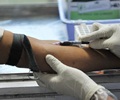High maternal hepatitis viral infection and co-infection with HIV are the key risk factors associated with the transmission of the hepatitis C virus to children.

"Our study analyzed the role of IL28B in HCV-VT and the spontaneous clearance of HCV among infected infants," said ngeles Ruiz Extremera, M.D., of San Cecilio University Hospital in Spain. The team recruited 145 mothers who were infected with HCV and gave birth between 1991 and 2009. All women were Caucasian 112 were HCV RNA positive and HIV negative; 33 were HCV RNA negative and HCV antibody positive. A total of 142 children were birthed by HCV-RNA positive mothers and 43 children to HCV-RNA negative mothers, all of whom were followed for six years or more. HCV-VT was defined as children who presented with HCV-RNA positive results from two blood samples.
Analysis showed that 61% of the 31 mothers with CC polymorphism, and 82% of the 68 mothers with non-CC polymorphism were HCV-RNA positive. There were 128 infants born to HCV-RNA positive mothers who were not co-infected with HIV and 20% of the children acquired HCV infection, with 7% of these being chronic cases. In mothers who were coinfected with HCV and HIV, the HCV-VT rate climbed to 43%. Researchers also noted that the rate of HCV-VT was higher among mothers who had elevated HCV viremia levels. Researchers did not detect HCV-VT in HCV-RNA negative mothers.
An increased risk of HCV-VT was not associated with the mothers' or children's IL28B status. However, researchers found that genotype non-1 and CC of the IL28B gene were involved with viral clearance among children infected with HCV. In regression analysis the child CC polymorphism was the only predictor of spontaneous HCV clearance in HCV genotype-1. "Our data are the first to account for HCV virus clearance and may provide important information about protective immunity to HCV," concluded Dr. Ruiz Extremera. "Further investigation is needed to understand the mechanisms involved with this genetic variation and the clinical impact of the IL28B variant on HCV infection."
Source-Eurekalert















